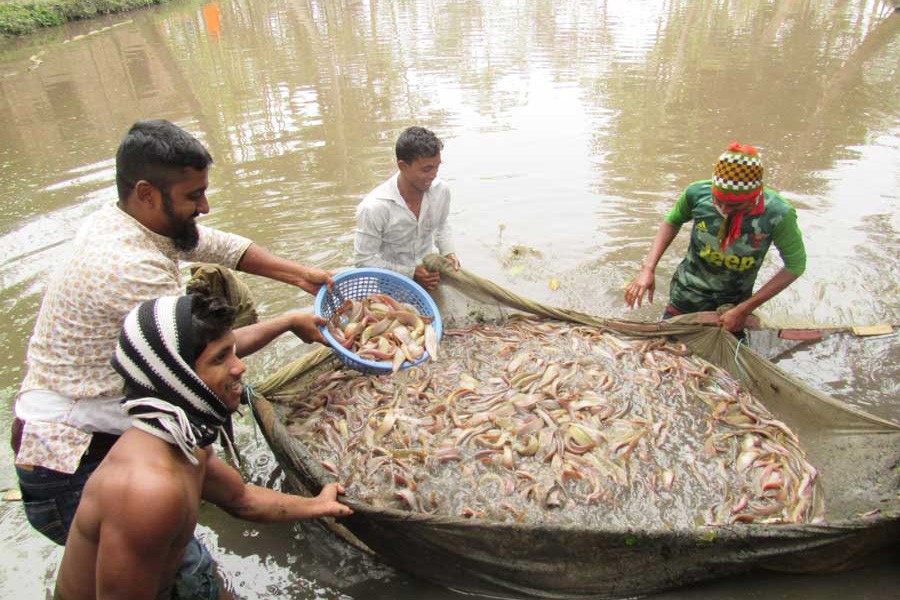
Published :
Updated :

MYMENSINGH, Jan 04: Barbel (shing) fish farming in Madihati Para village of Mymensingh Sadar Upazila has received a boost following implementation of the intensive cultivation technique that is set to benefit the farmers of the region.
Sources said, many people are becoming interested in the intensive cultivation of Barbel fish. In addition to the Madhihati village, the fishery farmers of Trishal, Phulbaria, Muktagacha, Nandail, Haluaghat, Bhaluka, and Sherpur of Mymensingh have started intensive cultivation of barbel fish. Intensive cultivation of high-valued barbel fish is more profitable than other currently cultivated fish species.
Based on the researches of the Bangladesh Fisheries Research Institute (BFRI), if the barbel is produced by the intensive method, a new dimension will be added to the fisheries sector.
Sources said, this technology will now be spread nationwide. Barbel fish will be available to the people of the country. The farmers will be benefited financially as well.
Usually fish farmers use half intensive cultivation technique to cultivate barbel fish. Chief Scientific Officer of BFRI, AHM Kohinoor said, research has shown that intensive cultivation of barbel fish can be easily done in ponds.
Abu Raihan, a farmer of Madihati Para village of Mymensingh Sadar Upazila, said five months ago, in a 0.32 acre pond, 5,000 barbel fish weighing of four grams were released. The average weight of the fish is 52 grams in five months after the time of release. The net weight of fish is 9,000 kg (280 kg per 0.01 acre). He sells fish at Tk 280 per kg in the wholesale markets and he earns about Tk 25 lakhs. The net profit is about Tk 1.1 million, excluding costs.
Talking to Abu Raihan on this matter, we have come to learn that, from the beginning, he followed the method of cultivating the barbel fish according to the advice of the scientists of the Institute.
He said, "I contact and consult with scientists of the institute regularly. Besides regular care of the pond and fish, I ensured regular balanced food supply for the fish. Also, I took care of stocking the minnow (pona) with the same size in the pond, especially the females, stocking with high density, applying regular lime and salt. Moreover, the water has to be changed regularly and the pond had been dug relatively deep."
Studies have shown that for the intensive cultivation of barbel fish, a 0.20-0.25 acre deep pond with shade should be selected. In order to eliminate the harmful germs from drying out pond, 50 grams of bleaching powder per 0.01 acre is required. The pond is then filled with pure water up to 1.5 meters.
After filling the pond with water, lime is applied at the rate of 500 grams per 0.01 acre. For the intensive cultivation of barbel fish, weighing of four to five grams 3,500-4,000 healthy and quality female barbel fish are stocked in the prepared ponds.
From the day after pona stock release, supplementary diet enriched with animal protein (32-35 per cent) can be applied at the rate of three to12 per cent of the body weight of fish.
Supplementary food should be given two times - at evenings and before sunrise.
For barbel fish cultivation, it is advisable to keep water quality at a suitable level. For this, it is necessary to check water quality regularly. After one month of pona stock, 100 grams of lime should be applied and after another 15 days of interval 400 grams of salt need to be applied. Otherwise the quality of the water will deteriorate.
A filtered net can be placed around the pond to prevent the entry of harmful aquatic organisms. To avoid the risk of infection of fish, biological security and effective preventive measures should be taken.
Generally, after six to seven months the fish will be ready for collection. At this time the average weight of the fish will be 55-65 grams. The pond must be completely dried to start collecting the fishes. Following this method, eight to nine tonnes of barbel fish can be produced from 0.50 acre pond within seven months.
Chief Scientific Officer of Bangladesh Fisheries Research Institute, AHM Kohinoor said that in case of such cultivation, the pond should be monitored closely so that the pond water is not wasted. In this case, it is particularly important to supply water quality three to five days a week.
Director General of the Institute, Yahya Mahmood said that barbel is a very popular fish in Bangladesh. This fish is low in fat and has a high quality of digestible protein, so there is a great demand for this fish. Their market value is much higher than the Rui fish.


 For all latest news, follow The Financial Express Google News channel.
For all latest news, follow The Financial Express Google News channel.